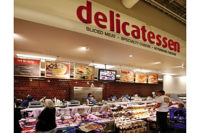It should come as no surprise to anyone who has paid attention to shopper trends, but consumers are looking to shop healthier at the deli. After all, they are shopping for better-for-you products everywhere else at the grocery store, so why not the deli? The trick is to find a standard definition of “healthy.” Ask five different shoppers and you’re likely to get five different responses.
“Healthy has meant a lot of things over a period of time, from calories to sodium content to fat content to protein content,” says Sudheer Kosaraju, marketing manager for Hillshire Farms.
The deli counter, as well as the rest of the perimeter of the typical grocery store, has enjoyed growth and an increase in consumer traffic. That growth has come at the expense of canned goods, shelf-stable items and frozen foods, says Amy Kraushaar, U.S. category manager, food and drink, for Mintel.
“What used to be the deli has now morphed into a whole host of different things, depending on where you are,” she says. Some delis have even grown to resemble a small restaurant or a food court at an upscale shopping mall.
“I know people who have said, ‘Let’s go have dinner at Whole Foods,’” she adds.
Lately, one of the macro trends affecting the entire food industry has been clean labels — no preservatives, no chemicals, no hard-to-pronounce ingredients. For many shoppers, that desire makes them more likely to choose the full-service deli counter over the packaged deli-meats section of the store. Kraushaar says consumers have tended to favor poultry items over red meat at the deli due to the perceived health benefits of poultry, and that sliced meats in general suffer because of negative consumer perceptions.
“Meat manufacturers are trying to help consumers find ways that meat can be healthy, but there is a lot of stigma around curing and nitrates, and consumers do not believe it is healthy,” she adds.
Michelle Lieszkovszky, brand manager, Deli (retail) for Butterball, says that despite the advancements made in packaging and food safety for sliced deli meats, “consumers are still reporting that they choose the full-service deli because they perceive that it’s more natural, [fresh] and healthy.”
There is a further trade-off with shopping at the deli counter, as consumers also perceive the meats sliced at the deli counter have a shorter shelf life than the packaged meats.
“But it’s also a strength,” she adds. “They’re thinking that if packaged lunch meat has a longer shelf life, then it’s automatically full of chemicals or preservatives. It’s a strength of the service deli to have that perception of wholesome.”
That conflict — balancing a longer shelf life against fresher products — is typical for the consumer whom Kosaraju calls the conflicted stress manager. She is a mom who has to balance a full- or part-time job along with an active family.
“She wants to buy — especially with staples like lunch meat — things that her family is going to enjoy,” he explains. “She ends up compromising a little bit in terms of what she wants for a cleaner label or fresher products.”
One of Hillshire Farms’ latest product releases was designed to help that conflicted stress manager find a product that satisfies the entire family. The new line of Hillshire Farm Naturals sliced deli meats contains no artificial ingredients, preservatives, colors or added nitrites or nitrates. Available in four varieties — Slow Roasted Turkey Breast, Hardwood Smoked Turkey Breast, Honey Roasted Ham and Black Forest Ham — they are packaged in a pouch and then placed in an air-tight plastic container to keep the meat fresher. The end result, Kosaraju says, is a product that contains the longer shelf life of sliced deli meats while featuring the cleaner, simpler label that shoppers want.
“That is the definition of health that we are seeing more and more in our engagement with consumers, and that is the area we have focused on,” he says.
Taste still matters
Although consumers may be changing their priorities in their food-shopping habits, their desire for great-tasting food hasn’t gone away. In fact, shoppers are looking for ways to elevate their sandwich experiences with new flavors and bolder tastes.
Lieszkovszky says that, once again, the desire for increased flavor favors the deli counter.
“Sometimes when you’re at the packaged lunch meat aisle, you have the choice of a lot of different brands, but you usually see honey ham, turkey and beef,” she says. “At the deli, you can get more flavors beyond your traditional varieties.”
It is a different scenario on the foodservice side of turkey sliced meats. Richie Jenkins, senior director of foodservice marketing for Butterball, explains that flavors are important, but the standard oven-roasted, oil-browned turkey breast is what drives that business. From there, restaurants can customize a dish or a sandwich to appeal to customers in their geographic region.
“What works in the Southwest might not work in the Northeast,” he says. “Foodservice operators want more of a solid base, a good turkey flavor to build upon, and then they can get into regional flavors with sauces or condiments.”
Jenkins says Butterball has in recent years focused on growth items such as turkey burgers, bacon or breakfast sausage. Butterball Foodservice is focusing back on the deli sector by offering a full line of turkey breasts, as well as some recipe ideas to help expand the universe for sliced turkey. Included in its offerings are Just Perfect Handcrafted Peppered Turkey Breast, Just Perfect Smoked TurkeyBreast, Deluxe Browned in Oil Turkey Breast and Carolina Turkey Classic Oven Roasted Turkey Breast. Along with all the other positive health attributes of turkey, the products are all gluten-free, which addresses another growing need consumers have.
Butterball’s culinary experts have also developed a range of recipe ideas for restaurants, from the Zesty Turkey Ciabatta Sandwich with Mango Salsa to the Tangy Asian BBQ Wrap.
“What we hear when we’re talking to operators and sales people, there is a lot of misunderstanding on the use of turkey,” Jenkins says. “It’s not just sliced on bread. We’re seeing growth in [other] categories from customers venturing outside of the traditional turkey product.”
Hillshire Brands’ Sara Lee Premium Meats has also released several varieties of flavorful deli meats, including Buffalo Style Chicken, Rosemary & Sage Turkey and Basil Pesto Chicken Breast, and it works with retail partners to promote the possibilities of deli meats, including in-store sampling and retail Web sites.
“As we get ready for back-to-school, we are excited to introduce Chipotle Seasoned Chicken Breast and Honey Maple Turkey Breast,” says Arnicia Harris, senior marketing manager for Sara Lee Premium Meats. “When delivering on taste, it’s also about offering more bold, complex flavors to meet the demand for richer palates. All these flavors speaks to offering a more bold and flavorful experience to the consumer.”
Harris also reports an increased usage of deli meats beyond the sandwich realm, including breakfast items, soups and salads.
“We have a great recipe for BBQ Chicken Pizza using our sliced-to-order chicken breast,” she says.
Challenges to chicken in prepared foods
According to Nielsen Perishables Group, prepared foods account for more than 50 percent of all sales made at the deli. Chicken is the mainstay protein, from rotisserie chicken to chicken salads to fried chicken, but processors are looking to diversify the prepared-foods section.
Chris Brady, senior manager of channel development at Sara Lee Foodservice, says the expansion of prepared foods into areas such as snacking has created a great opportunity for both manufacturers and retailers.
“The prepared-foods department creates a destination for consumers within the store and allows retailers to set themselves apart from its competition by providing high-quality food,” he says.
Sara Lee Foodservice focuses on items for the prepared-foods department that are easy for retailers to execute and allow them to provide more offerings than chicken. Those items include corn dogs, natural casing smoked sausage and beef pot roast.
Lieszkovszky says Butterball is seeing numerous opportunities for turkey in the prepared-foods section.
“We know consumers are seeking variety; it can’t just be chicken every week,” she says. “Turkey offerings in the prepared-foods section are a great opportunity for us and would allow consumers to enjoy turkey outside of the holiday meals, and without the hassle of trying to repurpose any of their Thanksgiving leftovers.”
The growth of the prepared-foods section could spur further growth and expansion of the deli department as a whole. After all, the supermarket is a place that provides food, so providing meals is a logical extension. Because consumers still are not cooking at home that often, retailers could market themselves as a legitimate alternative to dining out — and not just as a treat or a luxury.
“[Supermarkets] are gradually showing that they can prepare foods as well as or better than restaurants,” notes Mintel’s Kraushaar. “If the quality is there, the quantities that they are making are smaller, so it feels local. For a supermarket, that can help to build brand loyalty.”









Report Abusive Comment